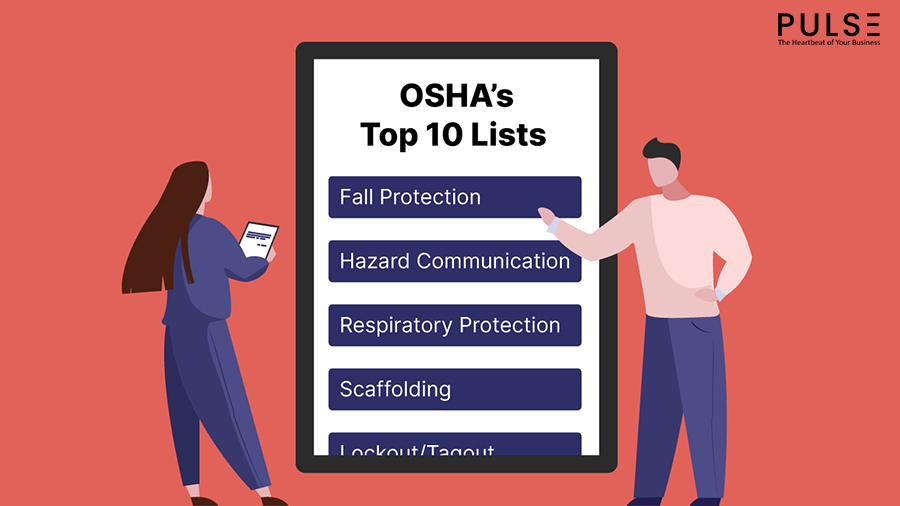Every year in April, the Occupational Safety and Health Administration (OSHA) publishes the most common OSHA standards cited during the previous Fiscal Year (FY). This is essentially a list of the top 10 standards most frequently violated by employers in the US during that period. But, the question remains:
Why does OSHA publish such a list?
According to the official website: “OSHA publishes this list to alert employers about these commonly cited standards, so they can take steps to find and fix recognized hazards addressed in these and other standards before OSHA shows up. Unfortunately, far too many preventable injuries and illnesses occur in the workplace.”
Therefore, the logic behind publishing a list of non-compliance is making employers aware of the most glaring and frequent non-compliance year after year and their severe implications.
OSHA not only publishes the commonly flouted standards and names, but they also provide in-depth details as to:
- how many times these standards have been cited due to non-compliance.
- the cumulative amount of penalty collected on account of non-compliance with that particular OSHA standard, and more.
Moreover, OSHA also provides a breakdown at an industry and sector level. For instance, in 2020, “Fall Protection (1926.501)” was the most frequently cited standard.
As per the statistics released, out of the 4,600 times ‘Fall Protection’ was disregarded; the total penalty of $24,845,459 collected under this violation, the construction sector accounted for a whopping 98% of both – the citations and penalties.
If we look at OSHA’s top 10 list for the past few years, it becomes apparent that, more or less, the list remains the same. The only change observed is the shift in some of the standards within the top ten.
For instance, between 2016 and 2020, Fall Protection, Hazard Communication, Respiratory Protection, Scaffolding, and Lockout/Tagout have consistently been amongst the top 5 cited standard violations.
This makes sure skeptics question the usefulness of publishing such a list year after year – since it pretty much remains the same. However, what makes these lists relevant is the wide range of insights, observations, and learnings that businesses can take from that data, even if the content seems similar on the face.
How OSHA’s Top 10 Helps Increase Compliance at the Workplace – The 4P Approach

The yearly list published by OSHA is a reminder of the severity of consequences of non-compliance towards OSHA standards and the resultant impact on the entire organization and its stakeholders.
Most importantly, this list helps employers improve the overall OSHA compliance of their organization. Let us see how:
1. PROVING That More Needs to be Done
The OSHA list brings to light some of the most commonly defied regulations set in place to secure the health and safety of employees. For example, despite having basic safety precautions in place, ‘Fall Protection’ (Standard 1926.501) continues to top the list every year, evidence that stricter compliance is the need of the hour.
Takeaway: Employers should take this list as a wake-up call that measures they are taking are not enough, and more needs to be done to ensure full compliance.
2. POINTING out Gaps in Implementation
Although many employers and organizations are well-equipped with gear, equipment, and training material to handle their employees’ workplace health and safety, the actual implementation is what often lacks behind.
Takeaway: A study of OSHA’s Top 10 helps understand which companies need to be put under focus. Then, the employer can conduct an end-to-end audit of these processes to ensure that they are appropriately implemented and that no gaps result in violations.
3. PROVIDING Insights
As mentioned above, employers can derive a lot of meaningful insights and takeaways from the OSHA list. For e.g., after a careful study of this list, an employer may conclude that a one-shot investment in an advanced audit tool can help solve most of their compliance issues plaguing his organization for multiple years.
Or, an employer may realize that simply focusing on providing quality and regular training to employees can ensure greater compliance with various OSHA standards. Also, an analysis of the penalties collected gives an idea of how much money can be saved by simply adhering to compliance better.
Takeaway: OSHA’s Top 10 list can be a resource savior – both financial and human – if studied carefully.
4. PATHWAY for New Organizations
New businesses looking to build their compliance framework can use the OSHA’s Top 10 list as a starting point – since those are the standards that need more focus and more stringent checks.
Takeaway: By studying the most frequent past violations, understanding how they can be avoided, and putting a robust system in place that ensures compliance with these standards, new businesses can learn from the failures of their peers and ensure a safer workplace.
Together We Can
OSHA’s list continues to remind organizations across the US that there is still a lot that needs to be done to ensure the well-being of employees. Therefore, this list should not be simply read as a routine publication. Instead, it should be taken as a metaphorical slap on the wrist, and a checklist of the common and frequent compliance violations that need to be addressed.
And that is where the 5th P comes into the picture – Pulse!
With Pulse, we provide you with state-of-the-art technology, intelligent checklists, and insightful reports to better monitor your organization’s compliance with OSHA standards. Register now to get a free demo and get access to exciting features.
